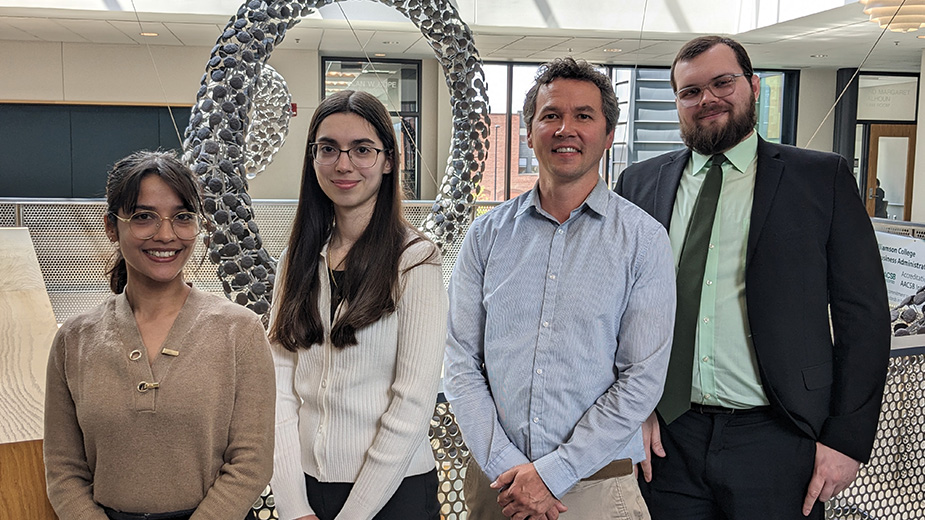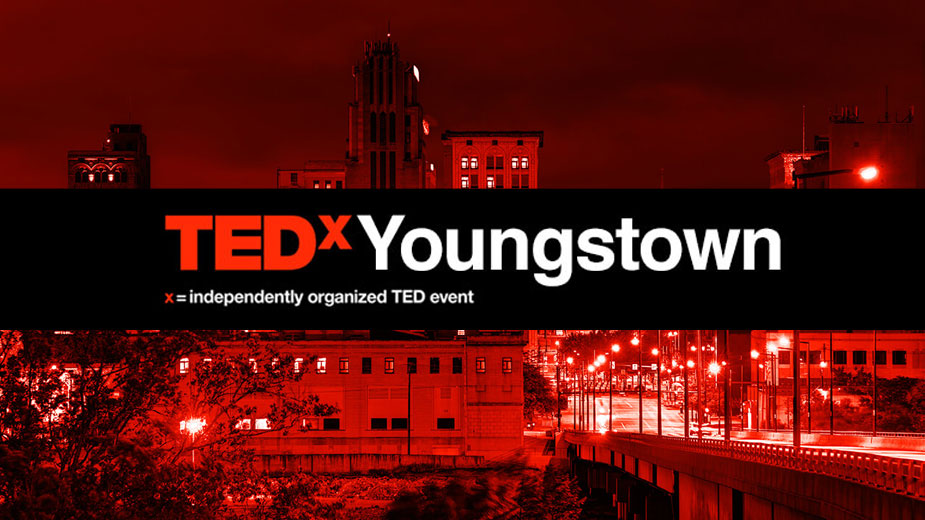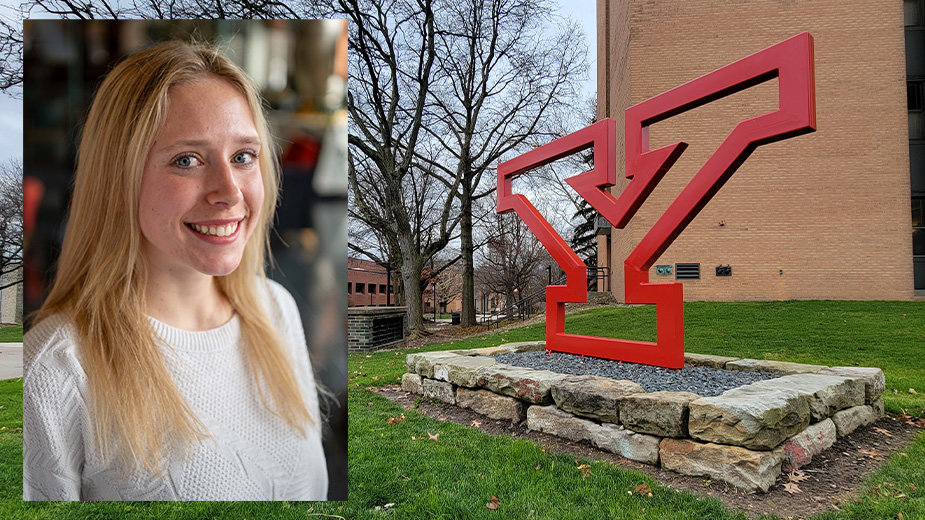YSU Students Present Insights for Valley Repopulation Strategies
YOUNGSTOWN, Ohio – The lack of high-paying jobs and quality housing are among the most common reasons some students attending Youngstown State University plan to relocate after graduation, according to findings presented Wednesday by students at the Williamson College of Business Administration.
The region also faces challenges from not just retaining its college graduates, but also attracting residents such as immigrants and refugees to the area, these findings suggest.
“Most people are either unsure or would be staying in the area,” said Jacob Graffius, a graduate student in economics at YSU who presented data that his group compiled. “While about 44% or so will be leaving.”
Sixteen students – five graduate and 11 undergraduate – enrolled in professor A.J. Sumell’s urban economics class spent the spring semester compiling statistics and gaining insights into how to help boost the region’s population.
“Project-based learning is the most effective kind of learning,” Sumell said. “What’s unique about this one is that it’s a class project not just for the sake of learning about urban economics – it’s a class project that’s very relevant to the outside community.”
Sumell said he learned about repopulation efforts after reading an article in The Business Journal that described efforts by organizations such as the Youngstown/Warren Regional Chamber and Eastgate Regional Council of Governments to address repopulation in the Mahoning Valley.
“It just seemed very timely,” he said of the class project.
Two student groups presented their findings Wednesday. The first surveyed samples of YSU students asking whether they planned to remain in the region after graduation.
According to their study, 23% of those surveyed said they would remain in the Mahoning Valley, while another 33% was undecided. The remainder of the sample, 44%, said they would relocate.
Those who graduated high school in the area were more likely to stay, according to the survey.
Among engineering majors, 27% said they planned to remain in the region, while 41% responded they were planning to leave. Another 32% of the sample was unsure.
The analysis also shows that a majority – 51% – of other science, technology, engineering and mathematics, or STEM, majors responded they planned to leave the area after graduation, while 17% said they would stay in the region. Approximately 32% reported they were undecided.
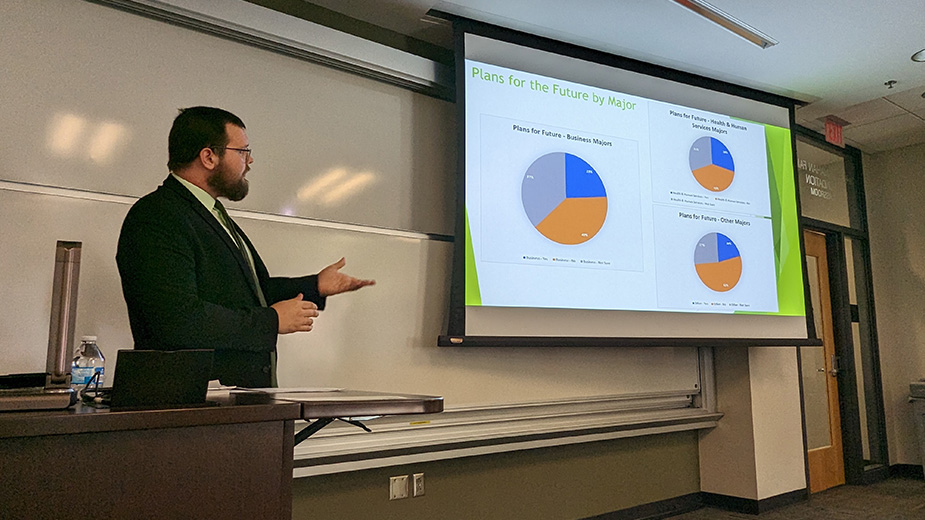
Graffius said many students emphasize the lack of entertainment options, quality housing and higher-paying job opportunities.
Yet the survey also showed that students at YSU were more optimistic about the future of the Youngstown region than the United States as a whole.
According to the class project, 37% of students said they were either mildly optimistic or very optimistic regarding the future of the Mahoning Valley, while 19% replied they were either mildly pessimistic or very pessimistic about its future. The remaining sample was neutral on the matter.
When it came to the future of the United States, 46% of respondents said they were mildly pessimistic or very pessimistic.
“I think a lot of this could offer a lot for policy for local organizations looking into the future to keeping our students here,” Graffius said.
Students Hunter Cosgrove, Anthony Czap, Diana Drobnjak, Nikolina Drobnjak, Theo Ovaska, Charles Quinn, Ryan Sinopoli and Bruce Wiggins also contributed to the survey project.
The second group examined how the Youngstown area could improve its population base through expanding opportunities for immigrants and refugees.
Student presenter Nikolina Drobnjak said the community needs to make it more attractive for immigrants and refugees through improved access to education, public transportation, career pathway programs, training opportunities and other services.
Her parents were refugees from Yugoslavia and arrived in Youngstown 25 years ago. “Having immigrant parents has made me realize how much we take for granted here. Just something as simple as driving to the grocery store,” she said, or communicating with others. “It takes years and years to get over those hurdles.”
Graduate student Kapila Ghimire, a co-presenter, showed through her group’s research that other communities with similar backgrounds and size as Youngstown have increased their population by embracing migrants and immigrants.
“The key takeaway was to see why and how some cities perform better in attracting refugees,” she said.
Other students contributing to the immigration and refugee study were David Akessah, Gavin Duwe, Greg Morgione, Mohammad Islam, Roman Ferry and Yaw Takyi.
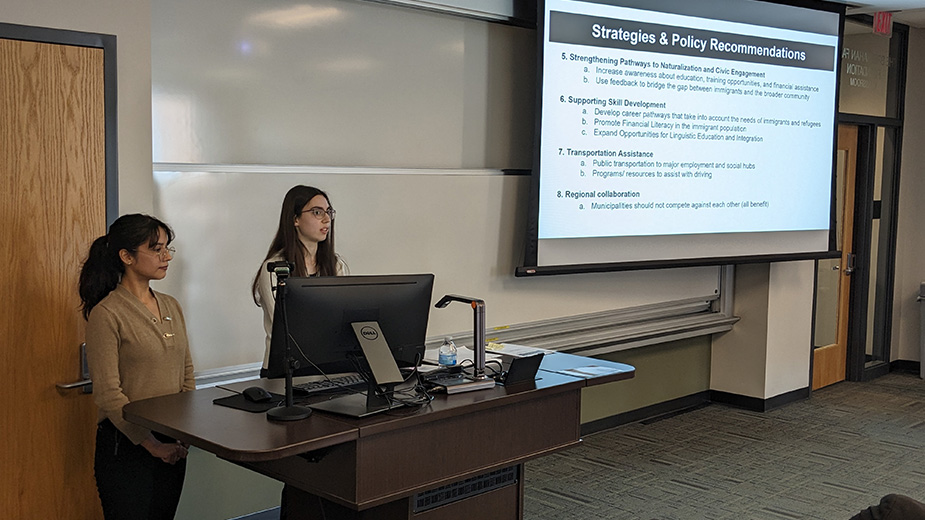
Ghimire and Drobnjak’s group featured examples from two cities: Utica, N.Y., and Allentown, Pa. Both of these cities witnessed industrial challenges similar to the Mahoning Valley during the 1970s but have taken different paths since then, students found.
Allentown and the Lehigh Valley, for example, is the fastest-growing metro region in the Northeast, their findings show. Since 2010, the population has increased by 6.2%, and Lehigh County is among the top 1% of all U.S. counties in terms of immigration.
Moreover, the young adult population increased by 10.7% in the past decade, fueled by additional entertainment options and cultural activities.
More than 60,000 refugees call Utica home, and the city’s refugee center – called The Center – has resettled more than 170,000 refugees over the past 40 years.
“They also receive state grants to make housing more affordable for refugees,” Ghimire said.
“The result has been that Utica and Allentown both have seen a higher influx of refugees, which has increased the overall population,” she said.
The Mahoning Valley should adopt strategies to increase educational opportunities for immigrants and refugees, make public transportation more accessible, develop workforce development programs for refugees and immigrants and work with private and public organizations toward affordable housing, findings show.
“It’s just the start of what I think could be a long-term analytical project,” YSU’s Sumell said. “It sets the stage for future research – not just the plans and preferences of YSU students, but also the plans and preferences of people outside of YSU.”
Pictured at top: From left, YSU students Kapila Ghimire and Nikolina Drobnjak; A.J. Sumell, professor of economics; and YSU student Jacob Graffius.
Copyright 2024 The Business Journal, Youngstown, Ohio.
